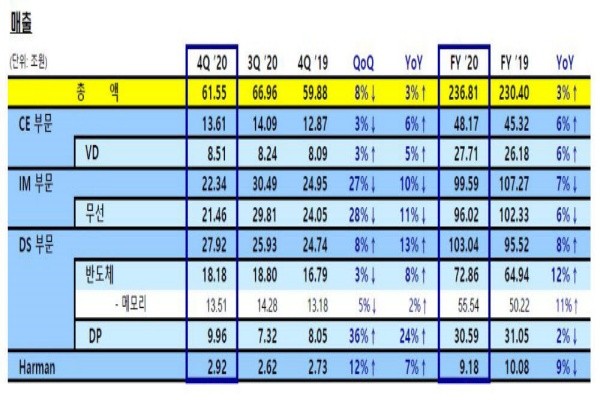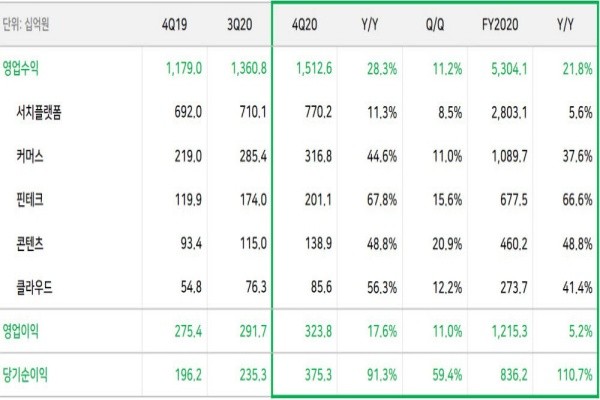Samsung Electronics and Naver were able to make record-breaking results in 2020 despite many unfavorable factors such as COVID-19 by actively looking for demands from the contactless economy and carrying out aggressive investments and customized strategies for different locations and fields while watching circumstances in overseas carefully. As the two IT companies that represent South Korea, they have been able to prove their capabilities in managing a crisis.
The two companies revealed their fourth quarter and annual performances on Thursday.

Samsung Electronics and its subsidiaries made $212 billion (236.81 trillion KRW) and $32.2 billion (35.99 trillion KRW) in annual revenue and annual operating profit respectively. Compared to 2019, their revenue and operating went up 2.7% and 29.6% respectively.
This is the fourth time their annual operating profit surpassed $31.3 billion (35 trillion KRW). While their annual revenue increased only slightly compared to 2019, it was the third highest annual revenue. These results indicate that they were able to make “record-breaking” results in 2020.
Samsung Electronics’ business in the first half was somewhat slow due to the global pandemic. However, it was able to rebound and attain its best quarterly performance in third quarter due to an explosion in pent-up demands and demands from the contactless economy. While its performance slowed down a bit in the fourth quarter due to exchange rates and intense marketing competitions, it still played a major role in raising the annual revenue as the company was able to make its highest sales in semiconductors (foundry) and display.
The company’s swift and preemptive strategies under a critical situation were the main reasons why the company was able to make a record-breaking result in 2020. In 2020, the company invested $29.5 billion (32.9 trillion KRW) and $3.49 billion (3.9 trillion KRW) in semiconductors and displays respectively regarding their facilities. It wanted to be proactive in expanding its infrastructures to prepare for the semiconductor market that is going through a “supercycle” and the display market that is expected to recover in 2021 and to supply mobile products.
The fact that it supplied reasonably priced products at the right time by carrying out a systematic global supply chain management and pushing to improve its cost structure through development of innovative process technologies and release of low and medium-priced 5G smartphones had also helped the company make a record-breaking performance.
“While we believe that there will be more demands this year compared to last year, there is still a risk of COVID-19.” said Seo Byeong-hoon who is a vice president at Samsung Electronics. “We plan to improve our competitive edge in price by accelerating transition to next-generation processes for different parts and components and focus on improving our product leadership.”

Naver had also experienced huge demands by focusing its efforts and capabilities towards the contactless economy. It was able to make its greatest annual performance in 2020 as all of its businesses such as search and commerce, fintech, contents, and cloud had made growths equally. Particularly, growth of its contents business had been the steepest as Webtoon has become a global business. It is likely that such trend will continue for Naver in 2021 as well.
Naver made $4.75 billion (5.3041 trillion KRW) and $1.09 billion (1.2153 trillion KRW) in revenue and operating profit respectively last year. Its annual revenue increase from 2019 when LINE’s performance is not included in the calculation. Naver’s revenue and operating profit when LINE’s performance is not included increase by 21.8% and 5.2% respectively compared to 2019.
The company made its biggest quarterly performance in the fourth quarter. It made $1.35 billion (1.5126 trillion KRW) in revenue, which is an 11.2% increase compared to the third quarter, and $290 million (323.8 billion KRW) in operating profit that is an 11.0% increase.
It made $284 million (316.8 billion KRW) in revenue from its commerce business in the fourth quarter which is an 11.0% increase compared to the third quarter. Its annual revenue from its commerce business was $976 million (1.0897 trillion KRW) that is an 37.6% increase compared to 2019.
Helping medium-sized companies and small and medium enterprises (SME) to be established in a digital environment and grow quickly through zero fee program for startups, marketing points for each step of growth, and expanded education program on contact-free digital transformation had proven to be effective.
Naver made $180 million (201.1 billion KRW) in revenue from its fintech business in the fourth quarter which is an 15.6% increase compared to the third quarter. The increase was the result of growth of Smart Store and growth of Naver Pay. Its annual revenue from its fintech business was $605 million (675.5 billion KRW) that is an 66.6% increase compared to 2019.
The company’s contents business had the highest growth rate. Based on growth of Webtoon, the company made $124 million (138.9 billion KRW) in revenue, which is an 20.9% increase compared to the third quarter. Its annual revenue was $412 million (460.2 billion KRW) that is an 48.8% increase compared to 2019. Along with the acquisition of Wattpad, the company plans to strengthen its partnerships with YG, SM Entertainment, and Big Hit Entertainment and continue to grow its global competitive edge in the contents field.
“In 2020, Naver had supported SMEs and startups and had grown together. We expanded our partnership towards partners with competitive edge in order to start new businesses and to become a global company.” said President Han Seong-sook of Naver. “We plan to expand our ecosystem through active R&D, investments and acquisitions, and partnerships and continue to put in efforts to grow together with SMEs and startups.”
Staff Reporter Jung, Yongcheol | jungyc@etnews.com & Staff Reporter An, Hocheon | hcan@etnews.com